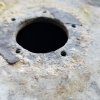- Joined
- Mar 2, 2020
- Messages
- 391
- Reaction score
- 125
- Points
- 43
- Age
- 61
- Location
- Courtenay, British Columbia
- Model
- Seafarer
Hello I’ve been working on my new to me 228G Seafarer and removed the floor panels to access and inspect and clean the water and fuel tank Compartments. I spent about 2 hours scraping and cleaning the old Sikaflex off. I realize that the floor panels need to be sealed for the majority of water and blood to flow out the scuppers but was wondering if everyone reseals them along the edges or just lets some of the water and blood drain into the bilge? I know this might be a dumb question but it’s the first self bailing Hull that I have owned, thanks and hope everyone is staying safe with this virus around.







